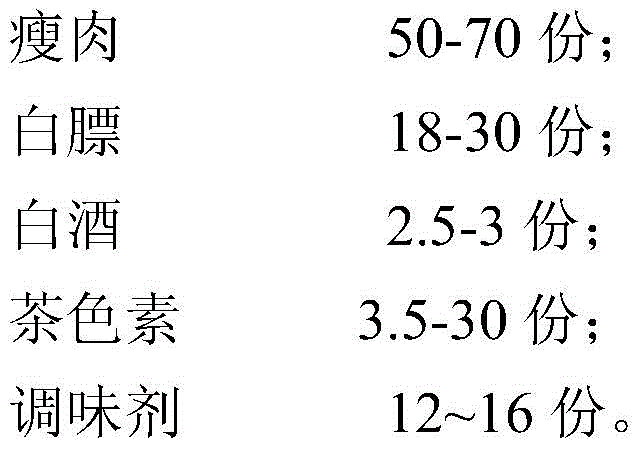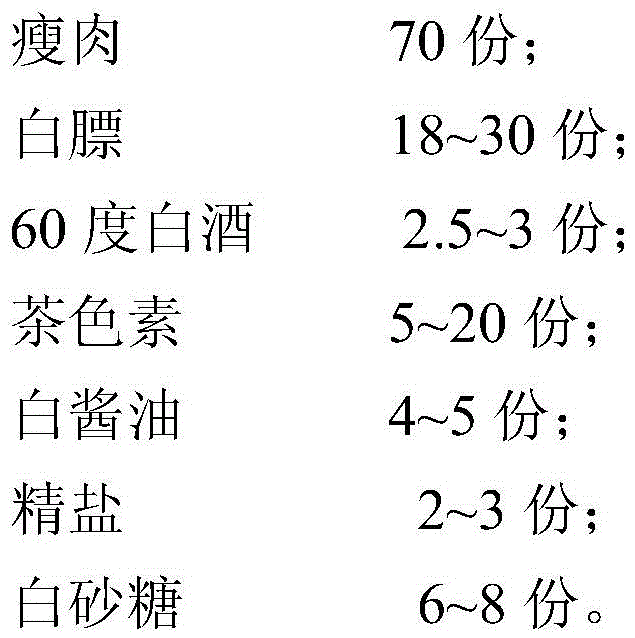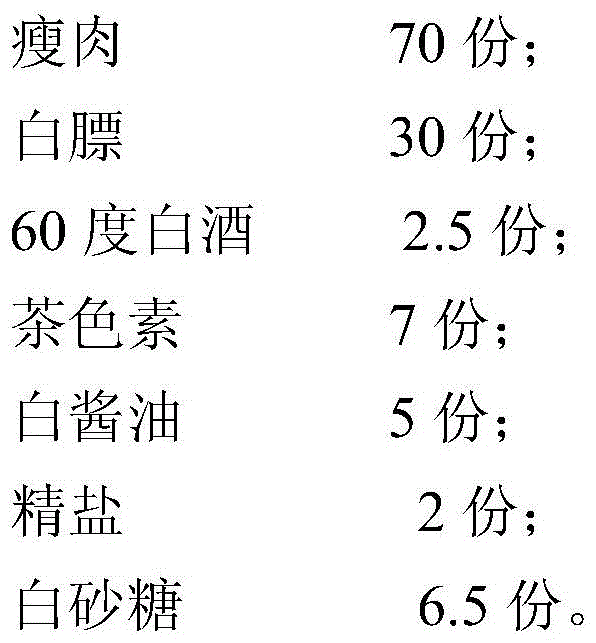Tea pigment sausage
A technology of tea pigment and sausage, which is applied in the field of meat products, can solve the problems of ineffective effects and side effects, and achieve the effects of reducing blood viscosity, bidirectionally regulating blood pressure and blood lipids, and reducing the use of synthetic substances
- Summary
- Abstract
- Description
- Claims
- Application Information
AI Technical Summary
Problems solved by technology
Method used
Image
Examples
Embodiment 1
[0031] 1. Selection and processing of raw materials
[0032] (1) Pork: Fresh pork hind legs are the main lean meat, followed by sandwich meat (not used for frozen meat). 1cm 3 Place the diced meat separately, wash the hard fat with warm boiled water to remove the slick oil, and drain it for later use.
[0033] (2) Ingredients: lean meat 70kg, white fat 30kg, 60% Daqu wine 2.5kg, tea pigment 7kg, white soy sauce 5kg, refined salt 2kg, white sugar 6.5kg.
[0034] (3) Preparation of other materials: small fresh pig or sheep casings are used for the casings. Soak the dry casings in warm water to soften and wash them before use. Drain and tie a knot at one end of the casings for later use. Generally, 1.5kg of hemp rope is used for processing 100kg of raw materials.
[0035] 2. Mixing material
[0036] Put the diced meat with a ratio of 7:3 of lean meat and fat fat in the container, and dissolve the rest of the ingredients with a small amount of warm water at about 50°C, add it ...
Embodiment 2
[0045] 1. Selection and processing of raw materials
[0046] (1) Pork: Fresh pork hind legs are the main lean meat, followed by sandwich meat (not used for frozen meat). 1cm 3 Place the diced meat separately, wash the hard fat with warm boiled water to remove the slick oil, and drain it for later use.
[0047] (2) Ingredients: lean meat 70kg, white fat 23kg, 60% Daqu wine 3kg, tea pigment 20kg, white soy sauce 5kg, refined salt 3kg, white sugar 8kg.
[0048] (3) Preparation of other materials: small fresh pig or sheep casings are used for the casings. Soak the dry casings in warm water to soften and wash them before use. Drain and tie a knot at one end of the casings for later use. Generally, 1.5kg of hemp rope is used for processing 100kg of raw materials.
[0049] 2. Mixing material
[0050] Put the diced meat with a ratio of 7:3 of lean meat and fat fat in the container, and dissolve the rest of the ingredients with a small amount of warm water at about 50°C, add it to ...
Embodiment 3
[0059] 1. Selection and processing of raw materials
[0060] (1) Pork: Fresh pork hind legs are the main lean meat, followed by sandwich meat (not used for frozen meat). 1cm 3 Place the diced meat separately, wash the hard fat with warm boiled water to remove the slick oil, and drain it for later use.
[0061] (2) Ingredients: lean meat 70kg, white fat 18kg, 60% Daqu wine 2.5kg, tea pigment 10kg, white soy sauce 4kg, refined salt 2kg, white sugar 6.5kg.
[0062] (3) Preparation of other materials: small fresh pig or sheep casings are used for the casings. Soak the dry casings in warm water to soften and wash them before use. Drain and tie a knot at one end of the casings for later use. Generally, 1.5kg of hemp rope is used for processing 100kg of raw materials.
[0063] 2. Mixing material
[0064] Put the diced meat with a ratio of 7:3 of lean meat and fat fat in the container, and dissolve the rest of the ingredients with a small amount of warm water at about 50°C, add it...
PUM
 Login to View More
Login to View More Abstract
Description
Claims
Application Information
 Login to View More
Login to View More - R&D
- Intellectual Property
- Life Sciences
- Materials
- Tech Scout
- Unparalleled Data Quality
- Higher Quality Content
- 60% Fewer Hallucinations
Browse by: Latest US Patents, China's latest patents, Technical Efficacy Thesaurus, Application Domain, Technology Topic, Popular Technical Reports.
© 2025 PatSnap. All rights reserved.Legal|Privacy policy|Modern Slavery Act Transparency Statement|Sitemap|About US| Contact US: help@patsnap.com



